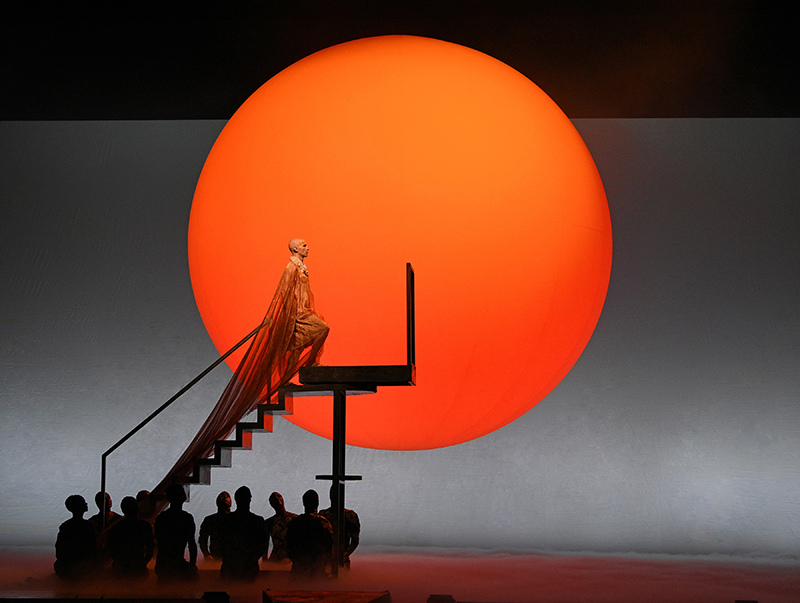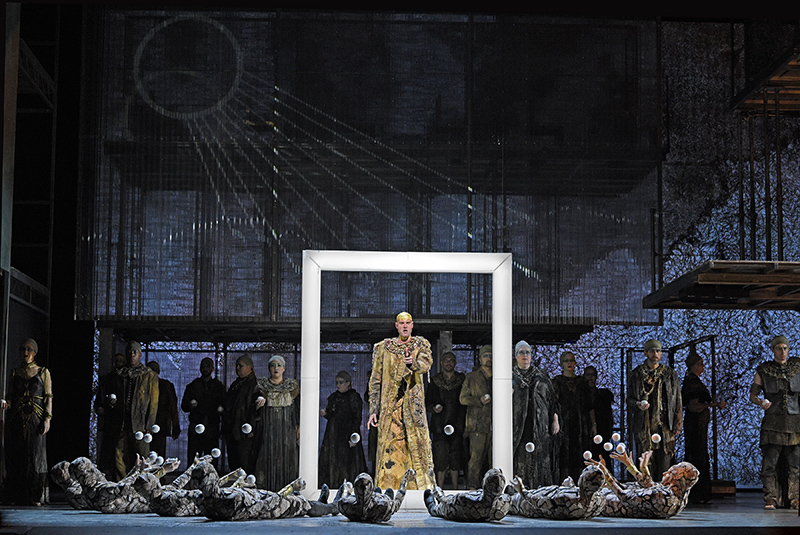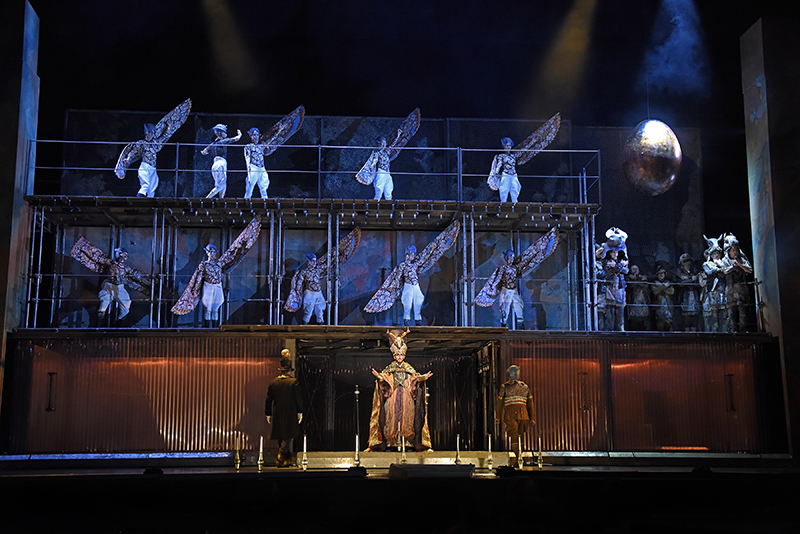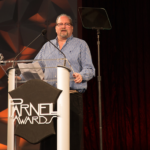
Of all the modern operas in the international repertoire, few present more staging challenges than the ones written by Philip Glass. The contemporary composer’s work throughout the 20th century became the very definition of minimalism in opera, as he wrote more than 20 characteristically rhythmic opera scores with what he called in press interviews “repetitive structures.”
Packed houses watch in rapture and incredulity as stage productions of Glass’s music unfold: operas including Einstein On the Beach, Satyagraha, Hydrogen Jukebox, and The Voyage draw fascinated audience members whether or not they have a working familiarity with the music. Glass’ operas are not your standard operatic fare, however: Limited librettos don’t follow a linear story line, instead taking on big concepts like a redefinition of space and time (Einstein), a vision of a nonviolent world (Satyagraha) and a song cycle based on 1960s beat writer Allen Ginsberg’s poetry (Jukebox). It’s up to the creative team to find a direction that reveals the heart of the work.
One question forms in every audience member’s mind as the lights dim and the curtain rises: “How on earth are they going to stage this?”
Akhnaten, one of Glass’s most famous operas, received its debut back in 1984 at the Stuttgart Opera in Germany, but it did not see its first performance at the Metropolitan Opera in New York City until November 2019. This new co-production with the English National Opera, a revival of a production that debuted at the London Coliseum in 2016, received its creative direction from a Glass opera aficionado: director Phelim McDermott.
“Akhnaten is an examination of a figure from ancient Egypt who was incredibly radical within that context of the ancient Egyptian world, in that he was the first pharaoh to bring about the birth of a religion which was monotheistic,” McDermott said in an interview on the Met’s website. “He had a very brief reign for 15 years, in which there was an extraordinary fruition of a kind of new aesthetic: a massive city was built, and almost as soon as it was created, this massive world he created was destroyed.”
The Akhnaten libretto contains section titles rather than narrative lyrics, and much of the lyrics consist of syllables instead of words … so the storytelling takes place through the staging. And what a staging it is: Cast members move as if in a dream state, taking minutes rather than seconds to cross a stage or climb a staircase. Arias and duets transpire with almost no movement by the singers. A non-singing narrator — the ghost of Akhenaten’s father, Amenhotep — provides some historical background, but even this is more poetic than descriptive, leaving the audience dazed as the score moves on with its perfectly measured, endlessly repeated phrases.
And there’s juggling. Lots of juggling.
“Akhnaten for me is exciting because it has a percussive, rhythmic, ritualistic feel to it,” said McDermott. To provide a visual interpretation of the music throughout the opera, McDermott chose the world-famous company Gandini Juggling and its artistic director, Sean Gandini, to turn Glass’s rhythms into a pulsing visual reality. The first jugglers came to light historically in ancient Egypt, McDermott said. “There are great hieroglyphics of people juggling. And you need to create in these pieces dramatically things that relate and translate to the music.”
McDermott selected Tom Pye, scenic designer; Bruno Poet, lighting designer; and costume designer Kevin Pollard to unite these elements with a visual theme. “Everything that Phelim did and everything in the approach to this opera was making tableaus that can last for a long time,” said Pye. “When I’m designing a Mozart, I’m desperately trying to work with huge sets going on and offstage at great speed, due to the lack of music written for changes. With Akhnaten, it was quite a different way of working, tableaus unfolding very, very slowly and having such a skilled team do that for us.”

Order from Chaos
The process began, Pye said, with a determination of what this production would not be. “We looked at a lot of depictions of Egypt on stage, and we joked that we didn’t want it to look like a bad Aida,” he said. “It can look a bit tacky, all gold. We felt that Egypt of that time would be a much darker and more interesting and sinister place if we looked at it with contemporary eyes. The more research we did, the more we found it to be strange.”
Rather than building a glitzy, literal set to represent the ancient country’s landscape and the pharaoh’s palace, Pye designed “a weird landscape of many different gods and slightly unsettling imagery of that religion of the time.” This represented the world into which Akhenaten was born, a shadowy realm filled with iconography and peculiar shapes.
The three-level scaffolding that forms the first act’s set allows the cast to emulate the stacked rows of hieroglyphics found inside the tomb of Tutankhamun, another Egyptian pharaoh. Jugglers in skin-tight leotards covered in a grouted rock pattern maintain stances that echo these early drawings, while a middle row of dignitaries stand dressed as twentieth-century archaeologists or as soldiers in ceremonial headdresses. At floor level, those attending to the new pharaoh come and go in robes trimmed with gold or virtually covered in it. Others appear in costumes that echo the early 1920s, the era in which Tutankhamun’s tomb was discovered, with top hats — sometimes with an embedded skull or other icon — or in garments that suggest modern dress.
The whole picture creates visual chaos, which was exactly what Pye intended. “That chaos — the music really mounts in the first scene, where we have the chorus revealed in the funeral of Amenhotep. There was too much to look at, with wheels and the body being embalmed. We wanted all of this to go against the aesthetic of Act II, using the imagery and the art of the old.”
All of the icons and shapes came directly from research, Pye claims. “I looked really closely at the Egyptian Book of the Dead,” he noted. “Wherever I was, I popped into museums. There were symbols in the Book of the Dead that I pulled out — they looked really modern.”
One of these became a glowing silver-white rectangular frame that flies in from above and tracks to one side or the other, surrounding Amenhotep as he enters in Act I. A skeletal staircase, moved in later by cast members, allows Akhenaten to ascend and take his place as ruler. “The frame to a degree and the staircase were imagery I found in the Book of the Dead,” Pye said. “I wanted to show how these could be seen as very contemporary. We’re not trying to recreate ancient times; we’re trying to show a contemporary audience something of that period and the link between these two aesthetics.”
Research led the designers in some fascinating directions, he added. “In our research, we found that Akhenaten and his wife actually had a window where the sun came up behind them every day. People would gather to see this amazing image of the pharaoh with the sun behind him. So we recreated that at the end of Act I.”
The set and lighting worked in tandem to sustain a mood throughout an hour-long first act, no mean feat while singers, supernumeraries and jugglers moved with excruciating slowness. “It’s a mood piece,” said lighting designer Bruno Poet. “It’s about tuning into the music and trying to find the lighting that resonates with that. Tom’s design is a very beautiful and interesting one to light. It gave me a lot of possibilities.”
The controlled, slow-motion movement becomes the critical factor in the storytelling, Poet said. “It’s about movement and how fascinating it can be,” he said. “When Akhenaten takes five minutes to walk across the stage and be crowned, I have to think about how the lighting should work with that movement. The pace of the music meant that we could really craft each moment, with slow subliminal lighting transitions. For example, the overture starts with incredibly slow color shifts on the front cloth — it starts coppery, then shifts to verdigris, then gold, then blue, almost imperceptibly. The ETC Lustr 2 with the 7-color LED was perfect for this. We then backlight the front cloth from behind the set with a 10K Fresnel that rises slowly, revealing the jugglers in silhouette. The front cloth rises to reveal a mysterious tomb lit only by the head torches of the archeologists; we eventually reveal the figure of a mummy in the tomb, and then another chamber comes to life to reveal the ghost of Akhenaten’s father. The lighting can help the audience focus on the story and can transform the set.”
Indeed, this focus helps immensely in determining what onstage is actually key to the story, and what is part of the overall spectacle — a distinction that sometimes is not obvious. Poet’s gorgeously ethereal lighting design goes well beyond directing the audience to the right place, however, especially when it comes to lighting the constant juggling — first with balls, then with pins, and later with inflated spheres the size of beach balls.
“I struggled with two things with the juggling: making sure that we see the balls or the pins, and making sure we didn’t blind the jugglers.” he states. “Sean spent a bit of time with us onstage, looking at angles. A lot of it is lit in sculpted backlight. There’s also a lot of high sidelight, catching the balls in the air but not right into the eyes. You just see the balls in the light, up in the air; you don’t see them in their hands.” To achieve this, Poet used low cross light from the tormentors to upstage and ETC Source Four LED Lustr2 fixtures at the shin-buster level.
The Met’s comprehensive lighting rig includes a wide range of fixtures: Lustr2s in many sizes provide much of the stationary lighting, with Altman Q-Lite luminaires as footlights and as visible sources on the set. Source Four Par MFLs for cross light, Claypaky Alpha Profile 800 ST units, Vari-Lite VL4000 spot luminaires and VL 3500Q spots make up much of the moving light inventory.
In addition to the robust options offered by the Met, Pye and Poet worked together to determine the placement and use of lighting built into the set itself, with Color Kinetics’ ColorBlaze TRX linear RGBAW fixtures bringing life to the three-level set in Acts I and III and Altman Q-Lites assisting in positions mounted to the floors and ceilings. Specific chambers within the scaffolding received their own lighting, including LED tape and Chauvet Nexus 4×4 LED wash panels, for their ability to generate diffused light in saturated hues.

Acts II and III
As Akhenaten introduces his subjects to the new monotheistic religion, the crowded visuals disappear and are replaced by a giant, glowing orb that fills the stage from top to bottom. Lit in part from the inside, in part by a rear projection screen, and finally by plenty of lighting above and around the stage, it becomes the sun, the one true god to the people of Egypt.
Bringing this image to life requires a more exciting solution than a flat, two-dimensional disk, Pye said. “I knew that I wanted it to be very pure and simple. Terry Gilliam had just done a show at ENO, and he used an inflatable statue. The Olympics a couple of years ago had inflatable towers. So I started looking at inflatables.”
The enormous white sphere remains boxed backstage throughout Act I and inflates in minutes during the intermission before it makes its appearance in Act II. “Bruno suggested putting LEDs inside the ball as well,” Pye said. “So we had a free area with a cyclorama upstage that could change color and projectors on the sides and in front.”
Poet found the process of lighting the sphere especially satisfying. “This is just a gift for a lighting designer,” he said. “Tom gave me the gift of the cyc and the big sphere, and said, ‘Go make something.’ It’s a 22-minute abstraction of sunrise, sunset, moonrise, moonset. You start with the white sphere with the jugglers, and then it has color, like dawn coming up; then it declines into a purply lavender twilight, and then the sky becomes rich and then shifts again as it dawns, and then it’s orange again as the curtain comes in. Where does one thing start and end? Can we find a structure in the music, where the shifts should be? There was quite a lot of playing with a stopwatch and timing and working with recordings. Then we spent a lot of time just playing it, looking at the shifts, making sure it had an elegant arc with the beautiful music.”
Poet lit the cyc with 38 Chroma-Q Color Force II LED fixtures above and on the floor. The sphere was lit with SGM’s Q-7 RGBW LED flood strobe lights, low-profile flood lights that double as wide-angle wash luminaires. “I miss the glow and warmth of the old 5Ks, but I did get in some traditional Lekos and PAR cans, just to get some of the light in the fabrics,” he said. “The Color Force II’s did a great job — we’d done the show at ENO with Color Force I’s, and the II’s are a definite improvement. You can use just the appropriate light at the appropriate angle.”
Add a substantial amount of haze, generated by a combination of MDG Atmosphere haze generators, MDG Ice Fog Q low fog generators, City Theatrical Aquafog 3300 dry ice fog machines, Rosco V-Hazer units and Power Tiny portable fog machines from Look Solutions, and the effect becomes breathtaking. “You need that in the air for the whole thing to work,” Poet said. “The haze holds shape — it feels very thin without it. It emphasizes the choice of angles we use and the directional sources of light, and it’s how the beams look in the air as well as on the floor and on the people. Haze is crucial.”
ETC’s EOS lighting console, the Met’s resident controller, also proved to be an important tool in managing the smooth transitions from one color to the next. “It’s fantastic that they have an EOS system,” said Poet. “Particularly in Act II, having the control of color shifts at the light desk — nothing else handles color quite the same way.”
The production schedule at the Met allowed Poet the time he needed to work out the transitions in tech, without the singers and orchestra. “We had three three-hour sessions in the summer tech sessions for the lighting,” he said, “so we had enough time, and then we had the staged orchestra rehearsals where we could tweak it and hone it. You can see what works and you can adjust it by instinct and experience.”
After the spectacle of Act II, the third act moves the action to a museum in the mid-twentieth century, where a lecturer does his best to control an unruly classroom as he describes the history we have seen unfold. “In the original production, it was a tour guide, showing tourists around the archaeological site,” said Pye. “We didn’t feel that was within the world we had made, so he became a lecturer.
We could use the same structure, and have a way of making the speech make sense without having to build ruins of the city.”
This also provided Poet with the opportunity to create a final lasting image. “Right before the end, Akhenaten comes to life,” he said. “The cyc is rich and blue, there’s golden light on him. The jugglers are rolling balls across the landscape, like sand and time. It feels like the whole show is summed up in one cue.”
Akhnaten posed a wide range of challenges for the creative team, but the result will remain in Met audiences’ memories for years to come. “It was a risk, with the juggling and the big sphere, and no one knew if it would all work,” said Poet. “But it all came together and it’s something really special.”

Randi Minetor is an author and freelance journalist based in upstate New York.


